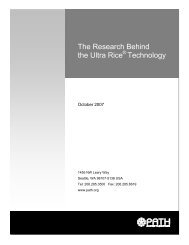STD Management for HIV and AIDS Prevention - Path
STD Management for HIV and AIDS Prevention - Path
STD Management for HIV and AIDS Prevention - Path
Create successful ePaper yourself
Turn your PDF publications into a flip-book with our unique Google optimized e-Paper software.
Three key problems were identified as contributing to high <strong>STD</strong> rates in<br />
the Philippines: lack of awareness of the protective effects of condoms<br />
against <strong>STD</strong>s <strong>and</strong> <strong>HIV</strong>, lack of appropriate <strong>STD</strong> care-seeking behavior,<br />
<strong>and</strong> lack of access to af<strong>for</strong>dable <strong>STD</strong> services. [7] USAID provided<br />
incremental funding in January 1996 <strong>for</strong> PATH to integrate <strong>STD</strong><br />
interventions into the ASEP education component. The objectives of the<br />
sub-project were to institutionalize private- <strong>and</strong> public-sector mechanisms<br />
to:<br />
• Reduce the prevalence <strong>and</strong> duration of <strong>STD</strong>s <strong>and</strong>, in turn, the<br />
spread of <strong>HIV</strong> among primary risk groups;<br />
• Encourage behaviors which reduce individual risk <strong>for</strong> contracting<br />
<strong>and</strong> transmitting <strong>STD</strong>s; <strong>and</strong><br />
• Promote social norms that reduce individual <strong>and</strong> collective<br />
vulnerability to <strong>STD</strong>s/<strong>HIV</strong>. [15]<br />
PATH recommended a focus on <strong>STD</strong> syndromic management as early as<br />
the first ASEP annual report [30]. The ASEP mid-term evaluation in<br />
1995 strongly recommended that USAID/Manila consider providing<br />
assistance <strong>for</strong> <strong>STD</strong> treatment <strong>and</strong> management in the public <strong>and</strong> private<br />
sector. By mid-1996 several <strong>STD</strong> sub-projects were in process under the<br />
ASEP Education component, including syndromic case management<br />
training, public service advertising about <strong>STD</strong> signs <strong>and</strong> symptoms,<br />
outreach education <strong>and</strong> referrals, <strong>and</strong> the development of alternative<br />
service points <strong>for</strong> people unwilling or unable to obtain care from the<br />
SHCs. [32] The first initiative was to train public <strong>and</strong> private health<br />
providers in syndromic case management <strong>for</strong> <strong>STD</strong>s because prior to ASEP<br />
few providers in the Philippines had been trained in improved approaches<br />
to <strong>STD</strong> management. During this training, it became clear that lack of<br />
<strong>STD</strong> management <strong>for</strong> <strong>HIV</strong> <strong>and</strong> <strong>AIDS</strong> prevention<br />
7

















